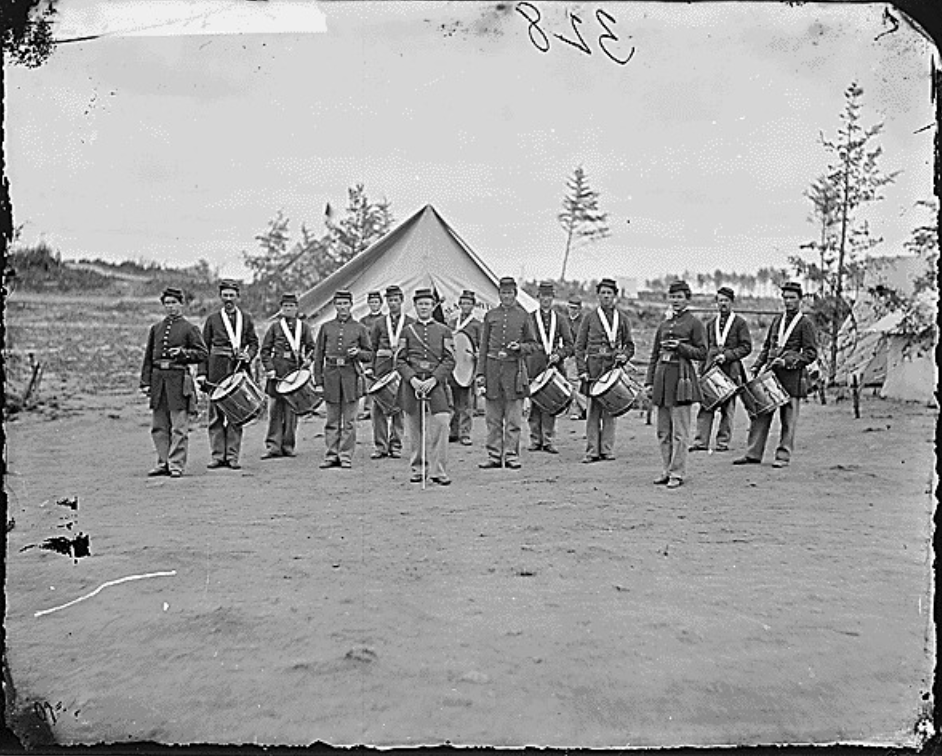During the American Civil War, an estimated 2.4 million men served in the Union Army, while around 1 million men fought for the Confederate forces. They faced the harsh realities of a new kind of warfare. However, beyond the military strategies and significant battles, the daily lives of Civil War soldiers—specifically their routines and personal experiences—are crucial for gaining a broader understanding of a conflict whose effects are still felt today.
This blog aims to delve into the life of an ordinary Civil War soldier, Union, and Confederate, and explore their daily experiences, challenges, and personal stories. By unearthing the intricacies of their lives, we aim to provide a more human, relatable aspect of the Civil War that often gets overlooked amidst discussions of political maneuverings and battlefield tactics.
If you would like to embark on your own exploration of important Civil War sites, be sure to check out our selection of Guided Virginia Battlefield Tours before you go.

Enlisting and Training for War
A wide variety of factors drove men to enlist during the Civil War. In the North, motives ranged from a sense of duty to preserve the Union, the lure of steady wages, or the desire for adventure. Many young people saw it as an opportunity to escape their everyday routines and embark on an exciting journey. In the South, the defense of the homeland, states’ rights, and preserving a way of life centered around slavery propelled men to join the Confederate Army.
The enlistment process was the first taste of military life for many. Physical examinations weeded out those deemed unfit for service (though standards were not necessarily strict, especially as the war dragged on). Once enlisted, basic training awaited the fresh soldiers. For both Union and Confederate armies, this involved learning military discipline, marching, handling weapons, and other rudimentary elements of soldiering.
However, training varied widely. In general, Union soldiers were better drilled and prepared due to the North’s industrial advantages and established military institutions. Confederate soldiers, though often less formally trained, were typically familiar with outdoor life and firearms, lending them certain advantages in the field.
The camp life was a drastic adjustment for all. The camps were often large and filled with sights, sounds, and smells that required plenty of adjustment. Troops slept in tents or hastily constructed shelters, usually in close quarters with their comrades, which promoted camaraderie, but also the spread of disease.
It was not uncommon for a soldier to share his living space with vermin, adding to the discomfort. Differences in daily camp life between the North and the South existed mainly in terms of supplies, as the industrialized North generally had better access to food, clothing, and equipment than their Southern counterparts. However, deprivation was felt on both sides.

Daily Routine for American Civil War Soldiers
A day in the life of a Civil War soldier, be it Union or Confederate, was marked by regimentation and routine. The day began at dawn with the bugle call known as “Reveille.” Soldiers would rise from their bunks, hastily tidy, and begin their morning drills.
Meals were a crucial part of a soldier’s daily life. For Union soldiers, a typical diet included salted pork or beef, hardtack (dense, dry biscuit), coffee, and sometimes fresh vegetables when available.
Confederates subsisted on a similar diet, but with cornmeal playing a larger role, given the South’s agrarian economy. Whether cooked in large camp kettles or over open fires, preparing meals often provided a welcome distraction from the tedium of camp life.
Daily duties varied but could include more drills, foraging, camp maintenance, or standing guard. As evening approached, soldiers would engage in leisure activities. These could include reading letters from home, playing poker or chess, or simply swapping stories.

Health and Hygiene for a Civil War Soldier
Health and hygiene were significant challenges in Civil War camps. The close quarters and often unsanitary conditions led to the rampant spread of diseases such as dysentery, typhoid, and pneumonia. In fact, disease killed more soldiers than battlefield injuries. Both Union and Confederate soldiers suffered, but the South, with fewer resources, often faced more significant health crises.
Hygiene practices included occasional bathing in nearby rivers or streams and attempts at shaving and doing laundry when possible. Dental health was a particular issue; toothbrushes were uncommon, and a poor diet led to many dental problems.
Injuries from training and combat were treated in field hospitals. These were often overwhelmed, and the medical knowledge of the time was insufficient to handle many of the injuries. Amputations were common, and pain management was limited. The introduction of the concept of triage by figures like Clara Barton helped organize medical care, but mortality rates remained high.

Battlefield Experiences
Whether wearing Union blue or Confederate gray, soldiers faced a terrifying range of sights and sounds on the battlefield that most were ill-prepared to encounter. Civil War battles were loud and chaotic. Smoke from muskets and artillery filled the air, often making visibility difficult. Commands were shouted, and the cries of wounded comrades echoed across the field. Many young soldiers, who had enlisted with romantic notions of warfare, quickly discovered that the reality was brutally unforgiving.
Post-battle, both armies had to deal with the aftermath, tending to the wounded, burying the dead, and dealing with prisoners of war. The high casualty rates often led to demoralization among the troops and required them to come to terms with their mortality.
The Challenges of a Soldier’s Life
Living as a Civil War soldier, whether in the Union or Confederate Army, presented a series of unique and daunting challenges. The weather was often harsh, with blistering summers and frigid winters testing the strength of the soldiers, who were often already malnourished and exhausted. The lack of proper clothing and shelter exacerbated these conditions. Long marches were a staple of the soldier’s life, often in adverse conditions and with little to eat.
These journeys were grueling, causing sore feet, exhaustion, and illness among the ranks. A soldier’s mental health was also significantly tested. The fear of impending battle, the longing for home, and witnessing the death of comrades led to conditions we would today recognize as post-traumatic stress disorder.
These stresses were often exacerbated by insufficient supplies, particularly for the Confederates, where food, clothing, and equipment shortages were more pronounced due to the Union’s naval blockade and the South’s lack of industrialization.

Relations with Civilians
The Civil War was a conflict that often blurred the lines between the home front and the battlefield. As armies moved through regions, soldiers would frequently interact with civilians. These encounters were marked by a wide range of emotions, from hostility to empathy.
Northern troops marching through Southern territory would often requisition supplies, sometimes burning crops and homes in a strategy known as “total war” aimed at breaking the South’s will to fight. This resulted in resentment and hostility from Southern civilians.
Despite being at odds, soldiers from both sides often had shared feelings regarding the war’s progression and aims. Union soldiers, especially at the war’s outset, generally fought to preserve the Union, while Confederate soldiers typically saw their fight as a defense against Northern aggression.
Personal Experiences
The experiences of Civil War soldiers varied greatly. For instance, the life of an African American soldier in the Union Army, having only recently been granted the right to serve, differed from a white soldier’s experience. African American soldiers often faced discrimination within their ranks and brutal treatment by Confederate forces if captured.
Similarly, many immigrant soldiers joined the Union Army and brought unique perspectives and experiences to their service. Soldiers’ ages also played a part in their experiences. Younger soldiers might be more prone to homesickness, while older soldiers may have been more set in their ways and found military discipline harder to swallow.
Despite these differences, moments of camaraderie were universal. Soldiers shared stories, food, and sometimes even read letters from home aloud in a group. The shared hardship created a unique bond among the men.

The End of the War and Its Aftermath
When news of the Confederate surrender at Appomattox Courthouse reached the ranks in April 1865, soldiers’ reactions were mixed. Union soldiers celebrated the end of the war and the preservation of the Union. For Confederate soldiers, the surrender signaled not only the end of the war but the collapse of the Confederate States of America, a cause for which they had fought and sacrificed so much.
Returning home presented its own challenges. Soldiers had to readjust to civilian life, finding work and reconnecting with families. The physical and mental scars of war lingered. Many returned with injuries that would affect them for the rest of their lives. “Soldier’s Heart,” what we now understand as post-traumatic stress disorder, was a common affliction.
In the post-war society, veterans played a critical role. They were involved in politics, with several former soldiers serving in state and federal government roles. Veterans also participated in maintaining the memory of the war by writing memoirs, attending reunions, and establishing monuments and memorials.
Visit the Historic Battlefields of Virginia
The life of a Civil War soldier, whether in the Union or Confederate army, was marked by the daily challenges of a harsh and demanding environment. By studying these aspects of a soldier’s life, we gain a broader understanding of the American Civil War beyond political maneuverings and battlefield tactics.
Understanding the life of a soldier also underscores the personal cost of war. Behind each statistic were men who faced the hardships of camp life, the fear and chaos of battle, and the challenges, if they survived, of returning to civilian life.
In the narratives of these ordinary men, we see the courage, resilience, and determination that defined a critical era in the American story.
Begin planning your own unforgettable American Civil War history trip today and book a Guided Tour of Virginia’s Battlefields or a Combo Tour of Two American Battlefields.
If you have any questions, please get in touch.


